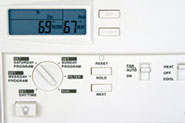
Energy Conservation at Work and Home
 Energy conservation can be done by households and factories alike. Some practical applications of energy conservation principles for individuals include weather-stripping and insulating homes; using storm windows or windows with double panes; turning off incandescent lights when leaving the area; turning off radios, TVs, and other electronic equipment when not in active use; and using timers for thermostats on electric heat pumps and water heaters.
Energy conservation can be done by households and factories alike. Some practical applications of energy conservation principles for individuals include weather-stripping and insulating homes; using storm windows or windows with double panes; turning off incandescent lights when leaving the area; turning off radios, TVs, and other electronic equipment when not in active use; and using timers for thermostats on electric heat pumps and water heaters.
Industrial consumers are using more heat pumps and are investigating dual energy use – the production of two forms of energy from one energy source. Certain industrial sites can use their own production by-products, like steam or heat, to help supplement their energy use by producing their own power.
One company in California processed walnuts and had tons of crushed shells as a by-product. The plant began to burn the shells to heat boilers that produced both heat and power.
Still other companies use steam to generate supplemental electricity or use clean left-over warm water in greenhouses or for irrigation.
About five per cent of the nation’s power is made by manufacturers who reuse their own companies’ by-products. This process is called cogeneration, and, in the truest sense of basic conservation tactics, it’s energy that otherwise would go to waste, put back to work in another form.
To learn more things that you can do to use energy wisely, visit Wise Energy Use.
